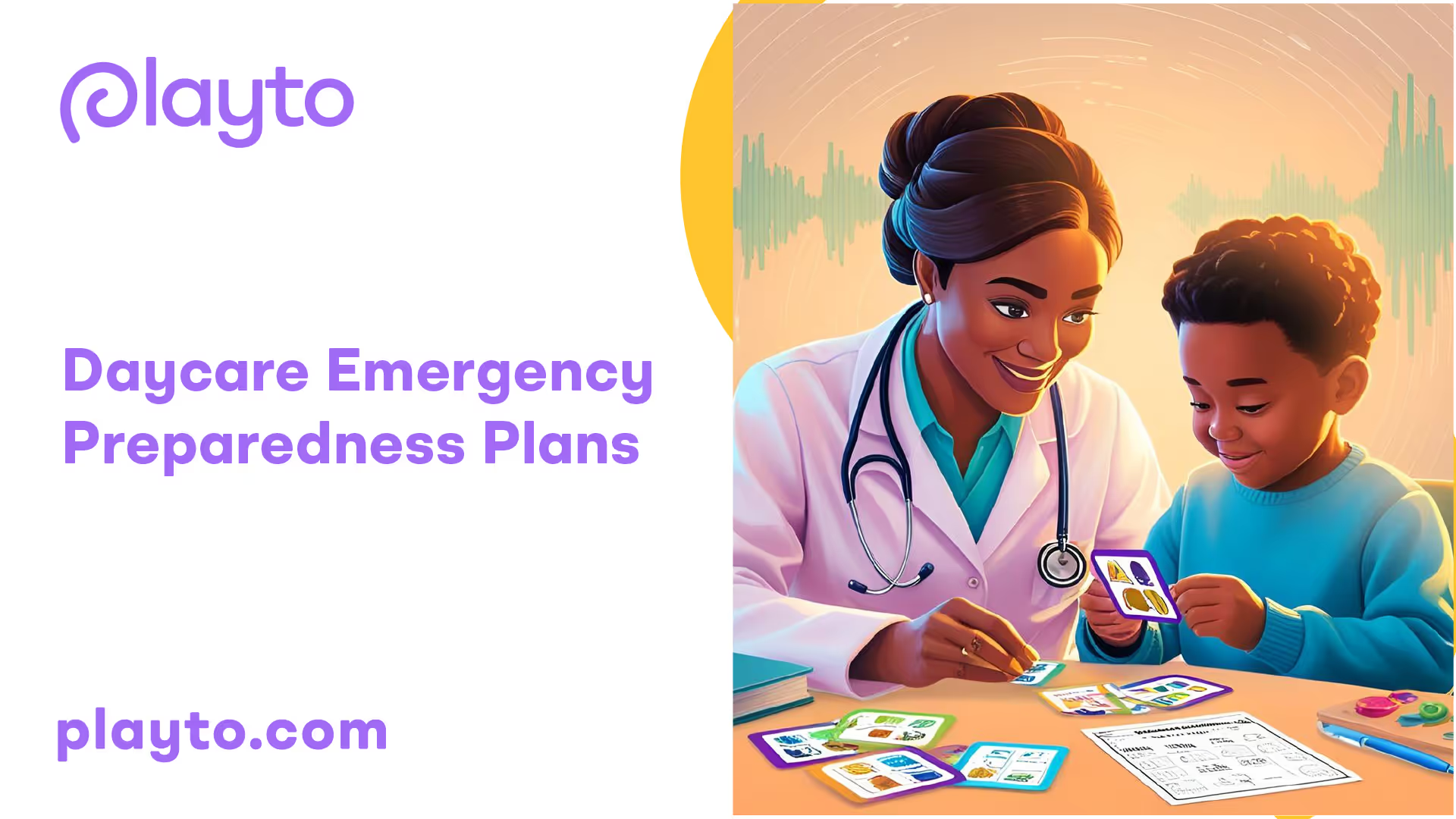Importance of Emergency Preparedness
When it comes to daycare centers, having a comprehensive emergency preparedness plan is of utmost importance. Such plans are designed to protect children and staff, foster a culture of safety, and ensure a quick and effective response to any emergency situation.

Protecting Children and Staff
The safety and well-being of children and staff members are paramount in any daycare setting. By implementing emergency preparedness plans, daycare centers can mitigate potential risks and protect children and staff from harm. These plans outline specific protocols and procedures to follow in the event of emergencies such as fires, severe weather, or medical emergencies.
Emergency preparedness plans help childcare providers and staff stay prepared and organized in the face of unforeseen circumstances. They provide guidelines on evacuation procedures, communication methods, and the allocation of responsibilities during emergencies. By having these plans in place, daycare centers can minimize the potential for injuries or fatalities and create a secure environment for everyone involved.
Culture of Safety
Developing a culture of safety is an essential aspect of emergency preparedness in daycare centers. By prioritizing safety and fostering a culture that values preparedness, daycare centers create an environment where everyone understands their roles and responsibilities during emergencies.
Emergency preparedness plans serve as a foundation for cultivating this culture of safety. They provide clear guidelines and protocols that promote proactive measures to prevent emergencies, as well as response strategies to handle emergencies effectively. Regular drills and practice scenarios also contribute to a culture of safety by familiarizing staff and children with emergency procedures and reinforcing the importance of preparedness.
By integrating emergency preparedness into the day-to-day operations of a daycare center, it becomes ingrained in the mindset of all individuals involved. This proactive approach ensures that everyone is equipped with the knowledge and skills necessary to respond appropriately during emergency situations.
To ensure that daycare centers are well-prepared to handle emergencies, it is important for them to comply with state regulations and licensing requirements. Most states require daycare centers to develop and maintain written policies and procedures for emergency preparedness. Additionally, regular emergency drills should be conducted to assess the effectiveness of the emergency plan and identify areas for improvement. By meeting these requirements, daycare centers can create a safe and secure environment for children and staff.
In the next sections, we will delve into the development of emergency plans, state requirements for childcare centers, key elements of emergency preparedness plans, staff training and health requirements, effective emergency management in healthcare, and the role of leadership in emergency management. Stay tuned to learn more about ensuring the safety and well-being of children and staff in daycare centers.
Developing Emergency Plans
When it comes to daycare emergency preparedness, developing comprehensive plans is crucial to ensure the safety and well-being of children and staff in the event of an emergency. Two key components of these plans are written policies and procedures, as well as conducting emergency drills.
Written Policies and Procedures
Most childcare centers are required to develop, implement, and maintain written policies and procedures for responding to emergencies, as stated by state childcare divisions and guidelines such as the Caring for Our Children National Health and Safety Performance Standards Guidelines for Early Care and Education Programs (4th edition) [2]. These plans describe the practices and procedures that should be followed during emergency or disaster situations.
Some important considerations when developing written policies and procedures include:
- Emergency Contacts: Clearly listing emergency contact numbers, including local emergency services and parents/guardians of the children.
- Evacuation Plans: Outlining evacuation routes, assembly points, and procedures for safely evacuating the facility.
- Shelter-in-Place Plans: Defining procedures for sheltering-in-place during emergencies that require staying inside the facility, such as severe weather events.
- Communication Protocols: Establishing clear communication channels and methods for notifying parents/guardians and authorities during an emergency.
- Medical and Special Needs: Addressing the needs of children with medical conditions or special requirements during emergencies.
- Staff Roles and Responsibilities: Clearly defining the roles and responsibilities of staff members during different types of emergencies.
By having written policies and procedures in place, daycare centers can ensure that everyone involved is aware of the necessary steps to take during an emergency. Regular review and updates of these policies are essential to keep them current and effective.
Conducting Emergency Drills
Emergency drills are practice situations that help increase the preparedness of both staff and children, confirming the reliability of the emergency plan and revealing areas for improvement [1]. Most states require childcare centers to conduct emergency drills every three months or twice a year to ensure that procedures are easily recalled by staff and children.
During emergency drills, various scenarios can be simulated, such as fire drills, lockdown drills, and severe weather drills. The drills should be age-appropriate and account for the specific needs of the children in the daycare center. Regular practice of evacuation and shelter-in-place drills helps ensure that staff and children are prepared to respond appropriately during emergencies.
The drills serve several purposes:
- Familiarization: They familiarize staff and children with the emergency procedures outlined in the written policies. This helps ensure that everyone knows what to do and where to go during an emergency.
- Identifying Gaps: Drills reveal any weaknesses or gaps in the emergency plan. This allows for adjustments and improvements to be made to enhance the effectiveness of the plan.
- Building Confidence: Regular drills build confidence among staff and children, as they become more comfortable with responding to emergencies. This can help reduce anxiety and promote a sense of security within the daycare center.
By incorporating both written policies and procedures along with regular emergency drills, daycare centers can enhance their emergency preparedness, creating a safer environment for children and staff alike.
For more information on emergency preparedness in daycare settings, check out our articles on technology use in daycare: pros and cons, the role of technology in daycare learning, the importance of reading in daycare settings, and transitioning from home care to daycare.
State Requirements for Childcare Centers
Ensuring the safety and well-being of children in daycare centers is of utmost importance. To meet this goal, state regulations often outline specific requirements for emergency preparedness in childcare centers. Two key aspects of these requirements are the frequency of emergency drills and compliance with regulations.
Frequency of Emergency Drills
Most states require childcare centers to conduct emergency drills on a regular basis to ensure that staff and children are prepared to respond effectively in emergency situations. According to Brightwheel, drills are typically conducted every three months or twice a year. This frequency allows staff members and children to practice emergency procedures regularly and helps ensure that the procedures can be easily recalled during an actual emergency.
By conducting drills regularly, childcare centers can identify any areas that may need improvement in their emergency preparedness plans. It also allows staff members to become familiar with their roles and responsibilities in different emergency scenarios. Practicing evacuation procedures, lockdown drills, and other emergency protocols helps to create a culture of safety and readiness within the childcare center.
Compliance with Regulations
Childcare centers are required to comply with state regulations regarding emergency preparedness. These regulations may be set forth by entities such as the Caring for Our Children National Health and Safety Performance Standards Guidelines for Early Care and Education Programs (4th edition), as mentioned by Child Care Aware. These guidelines suggest that facilities should develop and implement a written plan describing practices and procedures to prepare for and respond to emergency or disaster situations.
In addition to having a written emergency plan, childcare providers may also need to meet other requirements. For example, the National Resource Center for Health and Safety sets guidelines for evacuation drills, requiring every childcare and education program to have a written policy covering all potential emergencies. Furthermore, childcare programs must provide ongoing health and safety training to staff members to protect the health and safety of children. Federal law mandates specific training for staff caring for children receiving federal financial assistance.
By adhering to state regulations and ensuring compliance with guidelines, childcare centers can create a safe environment for children and staff members. Regular emergency drills and comprehensive emergency plans are integral components of an effective emergency preparedness program in childcare settings.
Key Elements of Emergency Preparedness Plans
When it comes to emergency preparedness in daycare settings, having a well-defined plan is of utmost importance. An effective emergency preparedness plan consists of three key elements: crisis preparation, response strategies, and recovery procedures.
Crisis Preparation
Crisis preparation involves anticipating potential emergencies and developing strategies to minimize their impact. This includes conducting a thorough risk assessment of the daycare facility and identifying potential hazards. By understanding the specific risks associated with the location, such as natural disasters or security threats, daycare centers can create a comprehensive emergency plan tailored to their needs.
Daycare centers should establish clear communication channels and lines of authority during emergencies. This ensures that everyone, including staff, children, and parents, knows how to receive and follow instructions. Regular training sessions and drills should be conducted to familiarize everyone with emergency procedures and promote a culture of safety.
Response Strategies
Response strategies are the actions taken during an emergency to ensure the safety and well-being of children, staff, and visitors. These strategies should be detailed and specific to address different types of emergencies, such as fires, severe weather, or medical emergencies.
For example, daycare centers should have procedures in place for evacuation in case of a fire or other immediate threats [3]. Additionally, shelter-in-place protocols should be established for emergencies where it is unsafe to evacuate, such as during a tornado or lockdown situation.
Training staff on emergency response protocols is crucial to ensure a prompt and effective response. Regular drills should be conducted to practice and reinforce these strategies. By simulating emergency scenarios, daycare centers can identify areas for improvement and make necessary adjustments to their emergency plans.
Recovery Procedures
Recovery procedures focus on returning to normal operations after an emergency has occurred. This includes assessing and addressing any physical or emotional damage caused by the crisis. Daycare centers should have protocols in place to ensure the well-being of both children and staff during the recovery phase.
Recovery procedures may involve working closely with parents and guardians to provide support and reassurance. Clear communication should be maintained to keep families informed about the situation and any changes to the daycare's operations. Additionally, daycare centers should have plans in place to address any physical damage to the facility and ensure a safe environment for children.
By having well-defined crisis preparation, response strategies, and recovery procedures, daycare centers can effectively handle emergencies and protect the well-being of children, staff, and visitors. It is essential for daycare centers to regularly review and update their emergency preparedness plans to align with changing regulations and best practices in the industry. For more information on emergency preparedness in daycare settings, consult resources provided by Child Care Aware.
Staff Training and Health Requirements
Ensuring the safety and well-being of children in daycare centers requires staff members to have proper training and meet specific health requirements. Daycare providers must prioritize ongoing health and safety training for their staff to maintain a secure environment for the children under their care. Additionally, federal law mandates certain training requirements for staff members who care for children receiving federal financial assistance.
Ongoing Health and Safety Training
Providing ongoing health and safety training to daycare staff members is crucial to protect the health and well-being of children. Regular training helps staff members stay updated on best practices, emergency procedures, and other important safety protocols. By being knowledgeable and skilled in areas such as CPR, first aid, and child supervision, staff members are better equipped to handle emergency situations and ensure the safety of the children in their care.
Federal law requires specific health and safety training for staff members who care for children receiving federal financial assistance [4]. This ensures that staff members are well-trained and competent in providing a safe and nurturing environment for children from diverse backgrounds.
Federal Law Mandates
To ensure the safety and well-being of children in daycare centers, federal law mandates specific health and safety training for staff members. These requirements help maintain a high standard of care and ensure that staff members are equipped with the necessary knowledge and skills to protect children's health and safety.
It is essential for daycare providers to adhere to these federal law mandates and ensure that all staff members receive the required training. By doing so, daycare centers demonstrate their commitment to providing a safe and secure environment for children.
To further support daycare providers in their emergency preparedness efforts, organizations like Child Care Aware® offer resources such as evacuation drill logs and guidelines for emergency policies. Regular practice of evacuation and shelter-in-place drills is crucial to ensure preparedness for emergencies in daycare centers.
By prioritizing ongoing health and safety training and complying with federal law mandates, daycare centers can create a culture of safety and effectively respond to potential emergencies. Staff members who are well-trained and knowledgeable play a vital role in safeguarding the well-being of the children in their care.
Effective Emergency Management in Healthcare
In the healthcare setting, effective emergency management is crucial to ensure the safety of patients, staff, and visitors. Two key components of successful emergency management in healthcare are clear communication protocols and comprehensive training programs.
Clear Communication Protocols
During emergencies, clear and efficient communication is vital to inform all personnel involved in managing the situation. Healthcare facilities must establish communication protocols that enable the seamless flow of information across various departments and roles. This includes medical staff, legal teams, government affairs, and facilities management.
By having well-defined communication channels and procedures, healthcare facilities can ensure that everyone receives timely and accurate information. This allows for coordinated decision-making and the implementation of appropriate response strategies. Clear communication protocols also help to maintain calm and manage the flow of information to patients, their families, and the public.
Comprehensive Training Programs
Comprehensive training programs are essential to prepare healthcare staff for emergency situations. These programs should cover a wide range of scenarios, including natural disasters, infectious disease outbreaks, and other emergencies that may arise in a healthcare setting. Training should involve not only medical personnel but also other staff members who play critical roles during emergencies, such as security personnel, administrative staff, and support staff.
Training programs should include both theoretical knowledge and practical exercises to ensure that staff members understand their roles and responsibilities in emergency situations. This may involve simulated drills and exercises that allow staff to practice their response strategies and familiarize themselves with emergency protocols. Involving the community in training plans is also crucial to ensure cooperation and coordination with local ambulance services, police, and fire departments.
By investing in comprehensive training programs, healthcare facilities can enhance the preparedness of their staff, improve response times, and ultimately save lives. Regular training and refresher courses should be conducted to ensure that staff members stay up to date with the latest protocols and best practices.
The clear communication protocols and comprehensive training programs play a vital role in effective emergency management in healthcare settings. However, it's important for healthcare facility leadership to prioritize emergency preparedness and allocate resources towards disaster preparations. This ensures that the facility can continue functioning during emergencies, safeguarding patient safety and maintaining revenue generation. By focusing on these key components, healthcare facilities can effectively navigate emergencies and provide the necessary care and support to those in need.
Asset Understanding and Disaster Preparedness
In the realm of daycare emergency preparedness plans, it is crucial for daycare centers to have a clear understanding of their assets and resources. This understanding helps them comprehend their capabilities and limitations, enabling them to effectively respond to emergencies and protect the children under their care. Healthcare facilities have also recognized the importance of asset understanding in disaster preparedness.
Identifying Capabilities and Limitations
Daycare centers must identify their capabilities and limitations in terms of resources, staff, and infrastructure. By conducting a thorough assessment, daycare centers can determine what they can effectively handle during emergencies and what areas may require additional support. This assessment includes evaluating the number of staff members trained in emergency response, the availability of emergency supplies and equipment, and the capacity of the physical space to accommodate emergency situations.
Understanding the limitations of the daycare center is equally important. It allows daycare providers to recognize potential vulnerabilities and areas that require improvement. This knowledge helps in developing strategies and protocols that address these limitations, ensuring a more comprehensive and effective emergency preparedness plan.
Technology Fail-Safes
In today's digital age, technology plays a significant role in various industries, including daycare centers. Daycare centers can utilize technology to enhance communication, streamline administrative tasks, and improve the overall learning experience for children. However, it is important to establish technology fail-safes as part of the emergency preparedness plan.
Daycare centers should have protocols in place to identify the hardware, software, and other technological resources required for operations during emergencies. By proactively assessing their technology infrastructure, daycare centers can identify and address potential vulnerabilities that may arise during disasters. This may involve having backup systems, redundant power sources, and contingency plans in case of technology failures.
By understanding their assets and technological capabilities, daycare centers can better prepare for emergencies and ensure the safety and well-being of the children in their care. It is essential for daycare centers to prioritize emergency preparedness and allocate resources toward disaster preparations, just as healthcare facilities have recognized the importance of these measures.
Leadership's Role in Emergency Management

In the realm of daycare emergency preparedness plans, strong leadership plays a critical role in ensuring the safety and well-being of children, staff, and visitors. Effective emergency management requires leaders to prioritize emergency preparedness and allocate resources for disaster preparations.
Prioritizing Emergency Preparedness
Leadership within daycare centers must prioritize emergency preparedness as a fundamental aspect of their operations. By recognizing the importance of developing and implementing comprehensive emergency plans, leaders create a culture of safety and demonstrate their commitment to the well-being of everyone within the facility.
Prioritizing emergency preparedness involves:
- Establishing written policies and procedures for emergency situations, including evacuation protocols, communication strategies, and safety guidelines.
- Conducting regular training and drills to ensure that staff members are familiar with emergency procedures and can respond effectively in high-stress situations.
- Collaborating with local emergency management agencies, such as fire departments and emergency medical services, to align emergency plans with community resources and response capabilities.
By making emergency preparedness a top priority, daycare center leaders create a safe environment for children, staff, and visitors, reducing the potential risks associated with emergencies.
Allocating Resources for Disaster Preparations

To effectively respond to emergencies, daycare centers must allocate the necessary resources for disaster preparations. This includes financial resources, personnel, and infrastructure investments.
Financial resources are required to:
- Develop and maintain emergency plans, including the creation of written policies, procedures, and training materials.
- Acquire essential emergency supplies, such as first aid kits, emergency food, water, and communication devices.
- Implement and maintain technology solutions that enhance emergency communication and response capabilities [5].
Personnel resources are vital for:
- Conducting ongoing staff training on emergency procedures, ensuring that all employees are equipped with the necessary knowledge and skills to respond effectively.
- Designating specific staff members to assume leadership roles during emergencies, coordinating evacuation efforts, and maintaining communication with emergency responders.
Infrastructure investments may include:
- Ensuring that the daycare center's physical facilities meet safety standards and are equipped with emergency exits, fire suppression systems, and other necessary safety features.
- Implementing technology fail-safes to ensure the continuity of operations during emergencies.
By allocating resources for disaster preparations, daycare center leaders demonstrate their commitment to the safety and well-being of everyone in their care.
Leadership's active involvement in emergency management creates a strong foundation for effective emergency preparedness within daycare centers. By prioritizing emergency preparedness and allocating the necessary resources, leaders ensure that the center is well-prepared to respond to emergencies and safeguard the children, staff, and visitors in their care.
